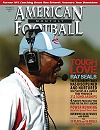Article CategoriesAFM Magazine
|
Drills Report – Building Pocket Awarenessby: Mike McCartyOffensive Coordinator Holmes Community College (MS) © More from this issue We believe that pocket awareness is one of the most important quarterback skills to develop. I did say develop. We don’t believe that most people are born with the ability to stand in the pocket and wait for people to run into them. We spend fifteen minutes a week during the season working on pocket awareness. On Monday, we spend five minutes re-enacting the pocket awareness situations that the quarterback should have handled more efficiently from the previous game. On Tuesday, we use five minutes of our individual time on pocket awareness. The last five minutes is used during Friday’s practice. We speed through all of our pocket awareness drills with great tempo to simulate game speed. We’ve put together a group of drills that will enhance the quarterback’s ability to avoid the pass rush. We implement the....The full article can only be seen by subscribers.
|
|
|||||||
| HOME |
MAGAZINE |
SUBSCRIBE | ONLINE COLUMNISTS | COACHING VIDEOS |
Copyright 2025, AmericanFootballMonthly.com
All Rights Reserved





